 This one is a simple pattern that I added a zigzag of triangles.
This one is a simple pattern that I added a zigzag of triangles. I'll have to get back to this in a bit--it needs a few pictures to exaplain...
This blog is devoted to patterns made with polygons. I'll try to have something interesting posted regularly.
 Maybe tomorrow I'll spiral this one but today I'll stick with concentric rings. The shells made of pentagons are decorated with triangles. The program that made this is not too sophisticated I think that when I try to make a spiral design I'll have to do a little more tinkering.... You'll just have to wait and see.
Maybe tomorrow I'll spiral this one but today I'll stick with concentric rings. The shells made of pentagons are decorated with triangles. The program that made this is not too sophisticated I think that when I try to make a spiral design I'll have to do a little more tinkering.... You'll just have to wait and see.


 I'm not sure why I'm calling this a jungle. This pattern is a variant of the one on Tuesday, August 15, 2006. The pattern comes from putting a zig-zag of triangles into every loop in the original. For instance, the original has loops or six pentagons that form a rhombus hole in the middle. Here the rhombus is transformed into curved triangles (the triangle in the middle is just for decoration). On close examination, There are still only two orientations of the pentagons--half the pentagons have a vertical side.
I'm not sure why I'm calling this a jungle. This pattern is a variant of the one on Tuesday, August 15, 2006. The pattern comes from putting a zig-zag of triangles into every loop in the original. For instance, the original has loops or six pentagons that form a rhombus hole in the middle. Here the rhombus is transformed into curved triangles (the triangle in the middle is just for decoration). On close examination, There are still only two orientations of the pentagons--half the pentagons have a vertical side. Perhaps I'm being a bit optimistic that people can see birds. The gaps that are not rhombic (like a diamond) remind me of birds. In the pattern, I see these birds circling around in big spirals. The program that generates this is a very short recursive program. The pentagons alternate between gray and orange. I was a bit surprised at first that there was only alternating colours in the pattern. Even though I programmed the colours to alternate, I am really only programming the polygons to fan in a tree-like fashion. There could be many incidental connections that occur. But on further inspection, all the loops have an even number of polygons so it would be impossible to have two of the same colour. In fact, since each colour represents a particular orientation two pentagon of the same colour can't share just one edge (they would have to share all five or none).
Perhaps I'm being a bit optimistic that people can see birds. The gaps that are not rhombic (like a diamond) remind me of birds. In the pattern, I see these birds circling around in big spirals. The program that generates this is a very short recursive program. The pentagons alternate between gray and orange. I was a bit surprised at first that there was only alternating colours in the pattern. Even though I programmed the colours to alternate, I am really only programming the polygons to fan in a tree-like fashion. There could be many incidental connections that occur. But on further inspection, all the loops have an even number of polygons so it would be impossible to have two of the same colour. In fact, since each colour represents a particular orientation two pentagon of the same colour can't share just one edge (they would have to share all five or none).
 I'm calling this pattern clover because of the negative space. Looking at the polygons though, it reminds of some sort of the three legged wheel that I saw in a weird movie... This pattern was developed using a zigzag technique similar to yesterday. The three squares zig one way then the other as they go from hexagon to hexagon.
I'm calling this pattern clover because of the negative space. Looking at the polygons though, it reminds of some sort of the three legged wheel that I saw in a weird movie... This pattern was developed using a zigzag technique similar to yesterday. The three squares zig one way then the other as they go from hexagon to hexagon.
 This one is not too inspired but...deal with it. It follows a similar construction to this one except the zigzagging here is with heptagons and the grid uses hexagons in the same layout as the the triangular grid (each hexagon only has edge connections with three hexagons rather than six). This is also similar to this construction. Perhaps the decorative red triangles should be a different colour....
This one is not too inspired but...deal with it. It follows a similar construction to this one except the zigzagging here is with heptagons and the grid uses hexagons in the same layout as the the triangular grid (each hexagon only has edge connections with three hexagons rather than six). This is also similar to this construction. Perhaps the decorative red triangles should be a different colour....



 Here's a polygon pattern that relies on a simple recursive call. Each heptagon attaches to two scaled down heptagons and each of those heptagons attaches to two more etc. This recursive definition is easy to do in PolygonR&D. The tightness of the spiral is determined by the main shrinking factor--the difference in size of the heptagon to the next biggest heptagon.
Here's a polygon pattern that relies on a simple recursive call. Each heptagon attaches to two scaled down heptagons and each of those heptagons attaches to two more etc. This recursive definition is easy to do in PolygonR&D. The tightness of the spiral is determined by the main shrinking factor--the difference in size of the heptagon to the next biggest heptagon.
 Once again I am playing with negative space--the pattern seems more about the four-point stars than the pentagons. This pattern (with different the colouring) is on the cover of the Tilings and Patterns: An Introduction (A Series of books in the mathematical sciences) by Branko Grunbaum and G. C. Shephard which is a great book. The last couple of blog entries have convinced me to slightly augment the language of the programming language of PolygonR&D to make the programs slightly easier to write. I'll let you know if it was worth it....
Once again I am playing with negative space--the pattern seems more about the four-point stars than the pentagons. This pattern (with different the colouring) is on the cover of the Tilings and Patterns: An Introduction (A Series of books in the mathematical sciences) by Branko Grunbaum and G. C. Shephard which is a great book. The last couple of blog entries have convinced me to slightly augment the language of the programming language of PolygonR&D to make the programs slightly easier to write. I'll let you know if it was worth it....
 Here's another spiral. This is made with nonagons (nine-sided polygons) and has three arms. Some difference between this one and the one yesterday is that the banana-shaped gaps are bigger and they have eighteen orientations instead of fourteen. Close to the centre of the pattern like the image to the left it appears curved like a true spiral but a bigger image would reveal the eighteen-sidedness. To show that there is no trickery about the nonagons nicely fitting together there is a close up included below.
Here's another spiral. This is made with nonagons (nine-sided polygons) and has three arms. Some difference between this one and the one yesterday is that the banana-shaped gaps are bigger and they have eighteen orientations instead of fourteen. Close to the centre of the pattern like the image to the left it appears curved like a true spiral but a bigger image would reveal the eighteen-sidedness. To show that there is no trickery about the nonagons nicely fitting together there is a close up included below.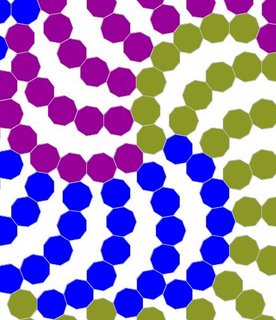
 Here's a spiral pattern made of heptagons. The fours groups of banana gaps between the heptagons form the four arms of the spiral. With close examination of the gaps, one can find fourteen different orientations, which are grouped together in wedges similar to the last pattern with alternating pentagons. This pattern was created using a short PolygonR&D program (50 lines for this two colour pattern or 15 lines if it were all blue).
Here's a spiral pattern made of heptagons. The fours groups of banana gaps between the heptagons form the four arms of the spiral. With close examination of the gaps, one can find fourteen different orientations, which are grouped together in wedges similar to the last pattern with alternating pentagons. This pattern was created using a short PolygonR&D program (50 lines for this two colour pattern or 15 lines if it were all blue).
 This pattern alternates two different orientations of pentagons. The pointing up ones are blue and the pointing down ones are purple. Notice that all but one of the pentagons (the central pentagon) are connected to exactly three other pentagons. The pattern can be thought of as concentric rings of pentagons (that will approximate decagons). Another way to understand the pattern is by grouping rhombi (the white diamond slivers) in terms of orientation--there are five different orientations. The rhombi form ten wedges that meet at the central pentagon.
This pattern alternates two different orientations of pentagons. The pointing up ones are blue and the pointing down ones are purple. Notice that all but one of the pentagons (the central pentagon) are connected to exactly three other pentagons. The pattern can be thought of as concentric rings of pentagons (that will approximate decagons). Another way to understand the pattern is by grouping rhombi (the white diamond slivers) in terms of orientation--there are five different orientations. The rhombi form ten wedges that meet at the central pentagon.
 This pattern is somewhat like Friday's pattern in that it uses some sections of a big loop inverted to make a loop with a star shape. The pattern alternates heptagons and triangles with the exception of the orange hexagons in the middle (heptagons didn't fit). It also has a flavour of August first's pattern since it has the same type of rotational symmetry. I prefer the August first because it offers a lot of the same interesting lines yet with a simpler design.
This pattern is somewhat like Friday's pattern in that it uses some sections of a big loop inverted to make a loop with a star shape. The pattern alternates heptagons and triangles with the exception of the orange hexagons in the middle (heptagons didn't fit). It also has a flavour of August first's pattern since it has the same type of rotational symmetry. I prefer the August first because it offers a lot of the same interesting lines yet with a simpler design.

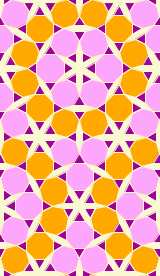 After a big battle with aesthetics, I finally settled on this pattern that makes a nice wall paper background (the image on the right). I'll highlight some of the battle. I originally started with a two colour pattern with just pink and purple. I thought it would have more impact than it did but I think with the regularity of the colouring that the pattern was dull. I added some colour it to make its bigger loops of twelve octagons and twelve triangles stand out. Even after I added orange to the mix it seemed too regular. The I introduced a twist to the pink loops of six octagons. To show you these transitions I'll added the pictures below. The key to recognizing the differences is to examine the negative space especially the asterisk like shapes. Notice there are two orientations in the pattern above as opposed to below where there is only one.
After a big battle with aesthetics, I finally settled on this pattern that makes a nice wall paper background (the image on the right). I'll highlight some of the battle. I originally started with a two colour pattern with just pink and purple. I thought it would have more impact than it did but I think with the regularity of the colouring that the pattern was dull. I added some colour it to make its bigger loops of twelve octagons and twelve triangles stand out. Even after I added orange to the mix it seemed too regular. The I introduced a twist to the pink loops of six octagons. To show you these transitions I'll added the pictures below. The key to recognizing the differences is to examine the negative space especially the asterisk like shapes. Notice there are two orientations in the pattern above as opposed to below where there is only one.


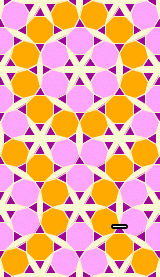
 I guess that I've been a bit obsessed with pentagons and triangles recently. This is mostly an alternating pattern but has a couple of hexagons and triangles. I guess I like this one because of the central curved pentagon. I wish I was able to find a better way to fill the inside of the outer loop...
I guess that I've been a bit obsessed with pentagons and triangles recently. This is mostly an alternating pattern but has a couple of hexagons and triangles. I guess I like this one because of the central curved pentagon. I wish I was able to find a better way to fill the inside of the outer loop...
 Sunflower
Sunflower This pattern is like the August first pattern: orange nonagons are used instead of heptagons. There are four more nonagons eight more triangles. The pattern arises from wiggly loop of nonagons that have been interlaced with a straight line of triangles. The inner and outer triangles that decorate the pattern help bring out its nine-fold symmetry.
This pattern is like the August first pattern: orange nonagons are used instead of heptagons. There are four more nonagons eight more triangles. The pattern arises from wiggly loop of nonagons that have been interlaced with a straight line of triangles. The inner and outer triangles that decorate the pattern help bring out its nine-fold symmetry.
 This pattern came about by elaborating a loop of interleaved triangles and squares. Each of the six loops on the outside of the central hub comes of a loop of squares and triangles where three of the triangles have been replaced with hexagons. The hexagons introduces spaces in the loops so that they can easily be connected (with squares) to one another while maintaining the original angles of the replaced triangles. As well, there are additional hexagons put in the central hub to make the negative space more eye catching.
This pattern came about by elaborating a loop of interleaved triangles and squares. Each of the six loops on the outside of the central hub comes of a loop of squares and triangles where three of the triangles have been replaced with hexagons. The hexagons introduces spaces in the loops so that they can easily be connected (with squares) to one another while maintaining the original angles of the replaced triangles. As well, there are additional hexagons put in the central hub to make the negative space more eye catching.


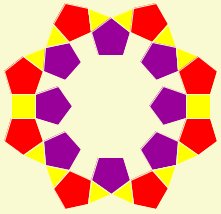 Here's another unravelled loop. A graphical representation of the process of creation is below. A pentagon loop (two partial stars) is combined with two loops of six triangles. The two gaps between the adjacent red pentagons are not filled with triangles (notice that there was originally fourteen gaps in the original loop and only twelve triangles)--these gaps are filled with squares and that are decorated with purple pentagons to maintain the alternating colours.
Here's another unravelled loop. A graphical representation of the process of creation is below. A pentagon loop (two partial stars) is combined with two loops of six triangles. The two gaps between the adjacent red pentagons are not filled with triangles (notice that there was originally fourteen gaps in the original loop and only twelve triangles)--these gaps are filled with squares and that are decorated with purple pentagons to maintain the alternating colours. 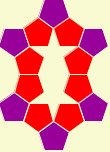 *
*  =
= 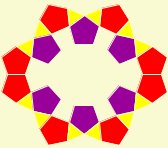 ...
... 


 Sometimes it's the missing tiles that make things interesting. Here there are a number of missing heptagons. A missing heptagon makes each of the gentler curve between the three triangles. Including the heptagons would lead to many overlapping polygons. Perhaps there is an artful inclusion of a selection of the heptagons...
Sometimes it's the missing tiles that make things interesting. Here there are a number of missing heptagons. A missing heptagon makes each of the gentler curve between the three triangles. Including the heptagons would lead to many overlapping polygons. Perhaps there is an artful inclusion of a selection of the heptagons...